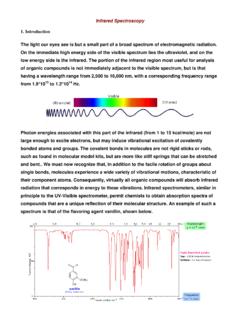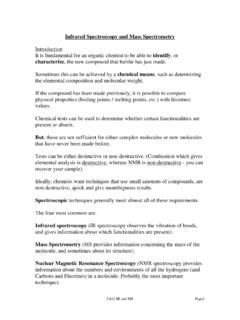Transcription of Characteristic IR Absorption Frequencies of Organic ...
1 1 IR Absorption Characteristic IR Absorption Frequencies of Organic Functional Groups Functional Group Type of Vibration Characteristic Absorptions (cm-1) Intensity Alcohol O-H (stretch, H-bonded) 3200-3600 strong, broad O-H (stretch, free) 3500-3700 strong, sharp C-O (stretch) 1050-1150 strong Alkane C-H stretch 2850-3000 strong -C-H bending 1350-1480 variable Alkene =C-H stretch 3010-3100 medium =C-H bending 675-1000 strong C=C stretch 1620-1680 variable Alkyl Halide C-F stretch 1000-1400 strong C-Cl stretch 600-800 strong C-Br stretch 500-600 strong C-I stretch 500 strong Alkyne C-H stretch 3300 strong,sharp stretch 2100-2260 variable, not present in symmetrical alkynes Amine N-H stretch 3300-3500 medium (primary amines have two bands.)
2 Secondary have one band, often very weak) C-N stretch 1080-1360 medium-weak N-H bending 1600 medium Aromatic C-H stretch 3000-3100 medium C=C stretch 1400-1600 medium-weak, multiple bands Analysis of C-H out-of-plane bending can often distinguish substitution patterns Carbonyl Detailed Information on Carbonyl IR C=O stretch 1670-1820 strong (conjugation moves absorptions to lower wave numbers) Ether C-O stretch 1000-1300 (1070-1150) strong Nitrile 2 CN stretch 2210-2260 medium Nitro N-O stretch 1515-1560 & 1345-1385 strong, two bands IR Absorption Frequencies of Functional Groups Containing a Carbonyl (C=O) Functional Group Type of Vibration Characteristic Absorptions (cm-1) Intensity Carbonyl C=O stretch 1670-1820 strong (conjugation moves absorptions to lower wave numbers)
3 Acid C=O stretch 1700-1725 strong O-H stretch 2500-3300 strong, very broad C-O stretch 1210-1320 strong Aldehyde C=O stretch 1740-1720 strong =C-H stretch 2820-2850 & 2720-2750 medium, two peaks Amide C=O stretch 1640-1690 strong N-H stretch 3100-3500 unsubstituted have two bands N-H bending 1550-1640 Anhydride C=O stretch 1800-1830 & 1740-1775 two bands Ester C=O stretch 1735-1750 strong C-O stretch 1000-1300 two bands or more Ketone acyclic stretch 1705-1725 strong cyclic stretch 3-membered - 1850 4-membered - 1780 5-membered - 1745 6-membered - 1715 7-membered - 1705 strong ,-unsaturated stretch 1665-1685 strong aryl ketone stretch 1680-1700 strong A good general reference for more detailed information on interpretation of infrared spectra (as well as other spectroscopic techniques) is Silverstein, ; Bassler, ; and Morrill, Spectrometric Identification of Organic Compounds.
4 4th ed. New York: John Wiley and Sons, 1981. S55 A more complete listing of functional group Absorption Frequencies ma be found in: Nakanishi, Koji infrared Absorption Spectroscopy. 3 Introduction to Structure Determination infrared : Characteristic Frequencies infrared Ultraviolet Mass Spectrometry NMR Crystallography Combined Even simple Organic molecules contain many bonds and have complex IR spectra. The IR spectrum of each molecule is different and can be used to identify it if its spectrum is on a database or library (see 'Fingerprint Region'). However, the IR spectra of related molecules often absorb at very similar and distinctive wavenumbers. The energy required to vibrate a functional group such as a carbonyl (C=O) or alcohol (O-H) is often very similar in different compounds and so molecules containing these functional groups show IR bands at wavenumbers which are Characteristic of these groups.
5 This leads to the most common and important use of IR spectroscopy in Organic and biochemistry: IR spectoscopy can be used to indicate the presence and absence of functional groups in Organic compounds. The table below lists the Characteristic IR absorptions of some common functional groups. When presented with the IR spectrum of an unknown compound, a table such as this can be consulted to work out which functional groups are present. Often as importantly, the absence of a Characteristic band can be used to work out which functional groups are not present. For example, if a compound is known to contain oxygen, the IR spectrum can often quickly clarify whether it is an alcohol, carbonyl or carboxylic acid group. If the bands expected for such groups are all absent, then it is likely that those groups are also absent.
6 Functional Group Absorption (cm-1) Intensity Comments Alkane C-H 2850 - 2960 Medium Sharp Alkene =C-H 3020 - 3100 Medium C=C 1640 - 1680 Medium Alkyne C-H 3300 Strong C C 2100 - 2260 Medium Alkyl halide Functional Group Absorption (cm-1) Intensity Comments Amine N-H 3300 - 3500 Medium Often broad C-N 1030 - 1230 Medium Aldehyde and ketone C=O 1670 - 1800 Strong Carboxylic acid C=O 1660 - 1740 Strong O-H 2500 - 3200 Strong Often broad Alongside the wavenumber of the Absorption (the x- axis on the IR spectrum), the amount of IR radiation absorbed (the y-axis on the IR spectrum) can also be Characteristic of the functional group. A bond connecting 2 atoms acts rather like a spring connecting 2 masses.
7 When it is stretched or compressed, there is a restoring force that acts to pull the atoms back. The vibrational frequency of a bond is given by the formula opposite where k is the bond force constant and m is the effective mass of the atoms. Bonds which are strong act like springs which are stiff: k is large and so is the vibrational frequency (and wavenumber). When the mass of the atoms is small, the vibrational frequency (and wavenumber) tends to be high. Hence: Vibrational Frequencies (and wavenumbers) increase in the order: single < double < triple, Vibrational Frequencies (and wavenumbers) for bonds involving the lightest element, H, are high and In general, it is harder to stretch than to bend so stretching vibrations tend to occur at higher Frequencies (and wavenumbers) than bends.
8 Vibrational frequency vibrational wavenumber 4 C-Cl 600 - 800 Strong C-Br 500 - 600 Strong Alcohol O-H 3400 - 3650 Strong Often broad C-O 1050 - 1150 Strong Arene C-H 3030 Weak C=C 1660 - 2000 Weak C=C 1450 - 1600 Weak Ester C=O 1670 - 1750 Strong Amide C=O 1630 - 1690 N-H 3140 - 3500 Strong 1 : two bands 2 : one band Nitrile C N 2210 - 2260 Medium Nitro NO2 1540 Strong The spectrum below is that of aspirin, shown opposite. The molecule contains: 2 carbonyl groups (one in the carboxylic acid group at the top and one in the ester group on the right). There is a single, broad band at just under 1800 cm-1 in the spectrum. The table above shows that this is consistent with C=O stretching vibrations.
9 Click on the left and right hand sides of the band to see the molecular vibrations which are excited at these wavenumbers. You will see that both C=O groups vibrate at the same time. You can rotate the molecule using your mouse. It also contains an O-H goup in the carboxylic acid group. There is a band at around 3200 cm-1 in the spectrum. The table above shows that this is consistent with an O-H stretching vibration. Click on the band to see the molecular vibration. You can rotate the molecule using your mouse. Click on the other bands in the spectrum to see the corresponding vibrations. aspirin







